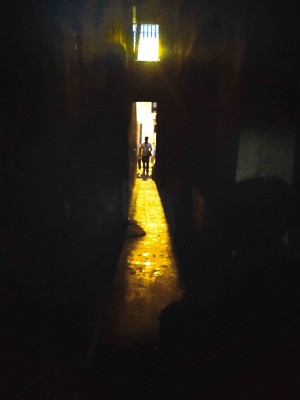
The existence of Area, notorious for its brothels, is an open secret in Angeles City. —RAIN C. YAMSON II
Angeles City—If Fields Avenue, the purveyor of commercial sex in this city in Pampanga province, has thrived without reinventing itself so much after the United States’ 13th Air Force pulled out from Clark Air Base in 1991, as ordered by the Philippine Senate, its poor man’s version, called Area, is on the brink of death.
Area, which had more than 1,000 “casas” (brothels) in its heyday, is left with only three. But it would not likely go without a trace in Barangay Sta. Teresita and Pampang here.
An indie film has paid tribute to it by telling stories about the struggles of prostituted women to keep their humanity while working in the flesh trade that catered only to Filipino men and boys.
The idea of making a movie about Area came from award-winning producer Ferdinand Lapuz, a native of Angeles. Kapampangan culture advocate Robby Tantingco wrote the screenplay that director Louie Ignacio put to life.
Comedienne Ai-Ai delas Alas convincingly tackled a rare dramatic role.
Local actors Eufrocina Peña, Cecil Yumul, Vicky Vega and Bambalito Lacap measured up to the levels of Allen Dizon, Sue Prado, Sarah Brakensiek, Ireen Cervantes, Tabs Sumulong and Sancho Vito delas Alas.
Comedienne Ai-Ai delas Alas leads a cast of veteran and amateur actors. —PHOTOS BY JAYPIE S. SINGQUE
Baby Go’s BG Productions International shelled out P5 million for the project—the 12th movie she has produced. “Maganda talaga, magagaling ang mga artista (It’s really beautiful, the actors were superb),” she said when the movie premiered in a cinema here last month.
The movie won the Special Jury Prize in the 12th Eurasia International Film Festival and made it to the official selection of the Tallinn Black Night Film Festival 2016.
Swan song
Tantingco said he wrote the screenplay as “a swan song to this strange and wonderful place—once a neighborhood of a thousand brothels now reduced to only two or three which, I suppose, will also soon be gone.”
“Except, of course, that we captured it on film,” he added.
Nobody could tell how the place got its name, but many other things surfaced from Tantingco’s research. It was where fathers and uncles brought their sons and nephews to discover and experience sex for P200, four cans of sardines, or a rickety electric fan.
Fields Avenue catered to US servicemen; Area had poor men. They are just 3 to 4 kilometers apart. Area, Tantingco learned, offered prostituted women a new place to work once they were no longer wanted at Fields.
“In the 1960s until the 1970s, truckloads of men regularly descended upon Area from as far as Hacienda Luisita in Tarlac [province] in the north and Macabebe and Apalit [towns] in the south—farmers, fishermen, market stevedores, tricycle drivers and, of course, the boys from Catholic schools with coins jingling in their pockets,” Tantingco said.
Ant hill
He also discovered that Area was “an ant hill with an elaborate subculture where Kapampangan families fed non-Kapampangan sex workers and lived off their earnings.”
The hierarchy, as it turned out, consisted of children who acted as “bugo” (runners and pimps), their older brothers as “casador” (who transacted with clients), and their parents as managers (operators of brothels).
The Hukbalahap (Hukbong Laban sa Hapon), and later, the communist New People’s Army, maintained safe houses inside Area, harboring guerrillas and activists.
But the perks in Fields—earning dollars from US troops fresh from combat duties, acquiring smuggled stateside (PX) goods, or marrying an American serviceman—were absent in Area.
Geographical distance
“Those realities and possibilities never extended to Area, for the simple reason of its
geographical distance from Clark, its being confined to the shadows and margins of Fields Avenue, and its residents being too far down in the food chain,” Tantingco said.
Two generations of community leaders of Barangay Sta. Teresita came to watch the film. Maria Luisa Bañola, former village chief, and her son, incumbent village captain Marino, were not upset about the truths told in the movie.
Maria Luisa said, “In my time (2002 to 2010 as barangay captain) there were still 100 casas. Now there are less than 10.”
“Medyo malakas pa noon (Business was still good back then),” she said of the period when young men were brought to Area for their rites of passage to manhood in small, smelly dark, flea-infested cubicles.
“Not many of the women were Kapampangans. They were mostly recruited from the Visayas and Mindanao. In my time, I banned minors. There were mothers among them and to their credit, their children finished school. One became a lawyer. Some graduated as teachers. There’s an engineer, too,” Maria Luisa said.
She said she would not close Area because many Sta. Teresita residents earned money by washing clothes for women in the brothels, sewing dresses for them, selling food to them or acting as their pimps. The women, in turn, took weekly pap smears.
What is causing the demise of Area? Maria Luisa traced that to competition at Fields but could not say what has been replacing Area.
Ignacio has earned good reviews and the one he likes best is the article which says his movie “gave dignity to every prostitute.”
Tantingco said: “I am glad we made ‘Area’ just in the nick of time. It’s a tribute to all the pimps and prostitutes who have disappeared into the night. It’s a tribute as well to all the Kapampangan boys who lost their innocence there and eventually grew up and disappeared into the crowd.”